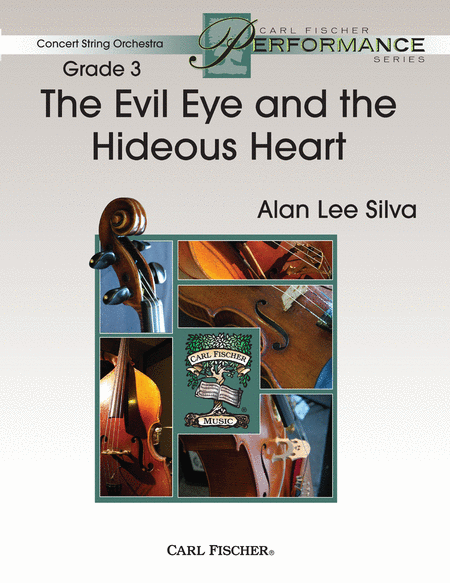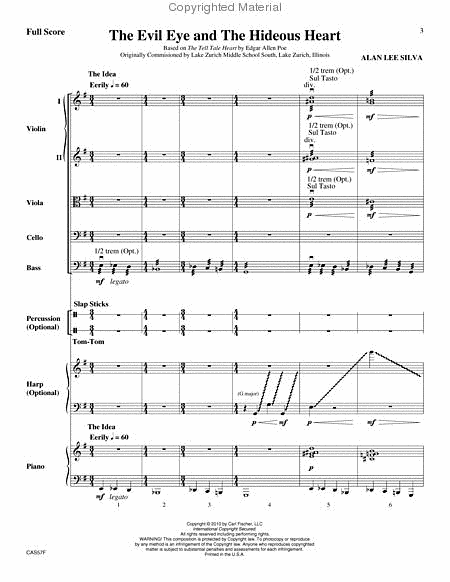The Evil Eye and the Hideous Heart
-
Ships in 1 to 2 weeks
Details
Description
SKU: CF.CAS57
Composed by Alan Lee Silva. Collate - FS SWS. Concert String Orchestra. Set of Score and Parts. With Standard notation. 24+24+6+15+15+15+7+3+4+28 pages. Carl Fischer Music #CAS57. Published by Carl Fischer Music (CF.CAS57).ISBN 9780825873560. UPC: 798408073565. 8.5 x 11 inches. Key: E minor.
Based on the classic Edgar Allan Poe short story The Tell-Tale Heart, composer Alan Lee Silva shows a more dramatic and darker side to his writing. Originally commissioned as a work reminiscent of a classic Hollywood horror movie theme, the piece follows the story of one of Poe's most famous thrillers. An excellent literary tie-in for your students studying the structure of a story in Language Arts, it appeals to their sense of mystery with a delicious touch of the macabre. The basses act as the low, ominous threat of danger, and the upper voices represent the insanity of the narrator's twisted plan. A real thriller! Duration: 4:52.
“I admit the deed!--tear up the planks--here, here! It is the beating of his hideous heart!”—Edgar Allan PoeOriginally commissioned as a work reminiscent of a classic Hollywood horror movie theme, the piece follows the story of Edgar Allan Poe’s Telltale Heart. An excellent literary tie-in for students who may be studying the story in Language Arts, it appeals to their sense of mystery with a delicious touch of the macabre.The piece is based on two main ideas: the slow, ominous bass notes at the beginning—two descending halfsteps followed by a major third; and the fast moving violin melody in E harmonic minor at m. 18. Optional harp and percussion parts are included, and the tom tom (preferably low tom) is used to bolster the cello and bass "heartbeat" effects, starting at m. 80. The section markers outline the story as it unfolds, beginning with "The Idea" in m. 1 as the narrator contemplates his murderous plan.The basses set the foreboding tone from the outset with their low tremolos, and the high strings add to the tension with their understated, heaving sustains. A strong accent and sustained tremolo from the full ensemble in m. 13, punctuates the end of the introduction and sets the deranged plan in motion.The violins set off with the quick, frenetic melody at m. 18, then are joined with accents in the violas at m. 16 and marcato chops in the cellos and basses. Basses have snap pizzicato effects starting at m. 28. A legato respite in the high strings with cello and bass punctuations, starting at m. 39, lead to vigorous marcato playing throughout the group at m. 47. Another break in the manic action occurs at m. 63 with descending tremolos in the high strings. The suspense and tension continue at a quieter, subtler level as the basses thump out the heartbeat. The silent bar at m. 79 is the pregnant pause before the maniacal odyssey gathers ferocity and continues to the end. The heartbeat pulse in the basses slowly becomes more intense at m. 80, and the sustained notes in the rest of the ensemble now give way to a manic marcato. The fervor is at the highest point at m. 112 as the heartbeat of cellos and basses is the quickest and the sustained tremolos in the high strings are the most impassioned. Aggressive unison sixteenth notes in the violins and viola lead to a crazed ensemble tremolo at m. 115 and the final punctuation at m. 119 as the narrator’s deranged journey comes to a close.
About Carl Fischer Concert String Orchestra Series
This series of pieces (Grade 3 and higher) is designed for advancing ensembles. The pieces in this series are characterized by:
- Expanded use of rhythms, ranges and keys but technical demands are still carefully considered
- More comprehensive bowing techniques
- Viola T.C. included
- Careful selection of keys and degree of difficulty for advancing musicians


 Share
Share